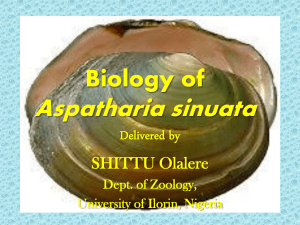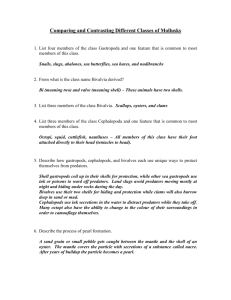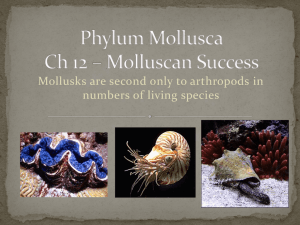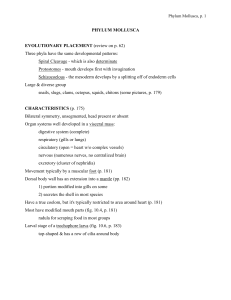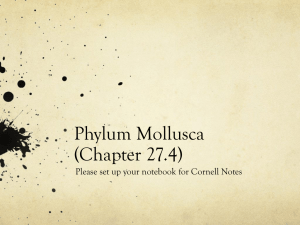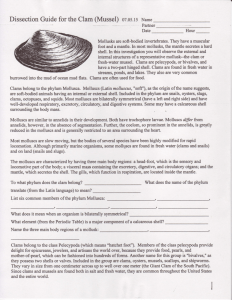topic13 BIOL1030NR
advertisement
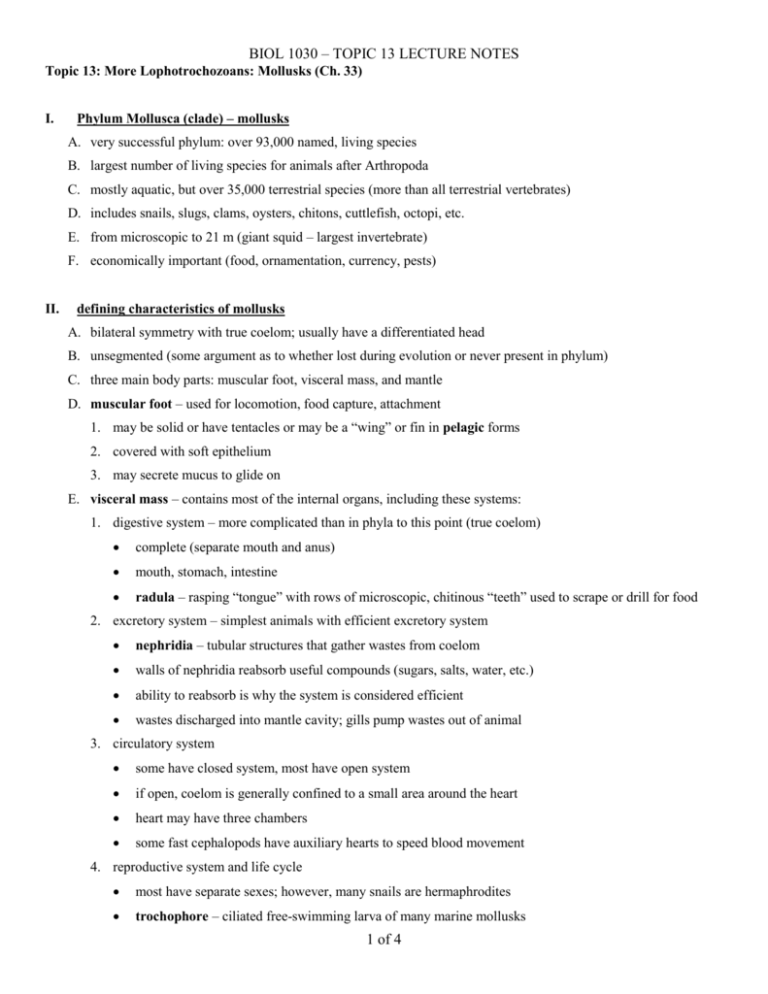
BIOL 1030 – TOPIC 13 LECTURE NOTES Topic 13: More Lophotrochozoans: Mollusks (Ch. 33) I. Phylum Mollusca (clade) – mollusks A. very successful phylum: over 93,000 named, living species B. largest number of living species for animals after Arthropoda C. mostly aquatic, but over 35,000 terrestrial species (more than all terrestrial vertebrates) D. includes snails, slugs, clams, oysters, chitons, cuttlefish, octopi, etc. E. from microscopic to 21 m (giant squid – largest invertebrate) F. economically important (food, ornamentation, currency, pests) II. defining characteristics of mollusks A. bilateral symmetry with true coelom; usually have a differentiated head B. unsegmented (some argument as to whether lost during evolution or never present in phylum) C. three main body parts: muscular foot, visceral mass, and mantle D. muscular foot – used for locomotion, food capture, attachment 1. may be solid or have tentacles or may be a “wing” or fin in pelagic forms 2. covered with soft epithelium 3. may secrete mucus to glide on E. visceral mass – contains most of the internal organs, including these systems: 1. digestive system – more complicated than in phyla to this point (true coelom) complete (separate mouth and anus) mouth, stomach, intestine radula – rasping “tongue” with rows of microscopic, chitinous “teeth” used to scrape or drill for food 2. excretory system – simplest animals with efficient excretory system nephridia – tubular structures that gather wastes from coelom walls of nephridia reabsorb useful compounds (sugars, salts, water, etc.) ability to reabsorb is why the system is considered efficient wastes discharged into mantle cavity; gills pump wastes out of animal 3. circulatory system some have closed system, most have open system if open, coelom is generally confined to a small area around the heart heart may have three chambers some fast cephalopods have auxiliary hearts to speed blood movement 4. reproductive system and life cycle most have separate sexes; however, many snails are hermaphrodites trochophore – ciliated free-swimming larva of many marine mollusks 1 of 4 BIOL 1030 – TOPIC 13 LECTURE NOTES veliger – second stage in development of most marine snails and bivalves; has beginnings of foot and mantle F. mantle 1. folds (often 2) from dorsal body wall 2. enclose a cavity between mantle and visceral mass (the mantle cavity) 3. mantle cavity - may act as lung or enclose gills gills are filamentous projections of mantle gills are rich in blood vessels gills have a large surface area for gas exchange continuous pumping keeps flow of water into and out of mantle cavity may have siphons to move water in (incurrent) and out (excurrent) of mantle cavity bring in oxygenated water and send out deoxygenated water may be used to bring in food (in bivalves) may be used for jet propulsion (in cephalopods) 4. shell (if present) – secreted by mantle, usually on outside, but on inside in some snails, squid, and cuttlefish, and lost in slugs, nudibranchs, and octopi provides protection one or two valves (shells) outer layer - horny protein layer; protects inner layers from eroding middle layer - densely packed crystals of calcium carbonate (calcite or aragonite) inner layer - pearly - increases in thickness throughout life of mollusk pearls form between the inner layer and mantle in bivalves III. Mollusk taxonomy A. 7 or 8 classes; we will cover 4, all of which appear to be clades B. Class Polyplacophora (clade) – chitons 1. ~1000 living species 2. marine; shell is segmented with 8 overlapping, calcareous plates 3. body beneath shell is not segmented 4. head is greatly reduced 5. foot used for locomotion and for holding onto substrates C. Class Gastropods (clade) – snails and slugs 1. name means “stomach foot” 2. ~70,000 living species 3. mostly marine, but abundant in freshwater, and many are terrestrial 4. most have a shell 2 of 4 BIOL 1030 – TOPIC 13 LECTURE NOTES single shell, if present operculum found in most marine gastropods – a horny plate that forms a covering “door” when the snail withdraws into its shell coiling (spiral twisting) of shell due to one side of larva growing faster than the other side shell has been lost in the course of evolution for slugs and nudibranchs (sea slugs) 5. body clearly divisible into head, foot, and visceral mass head of most has a pair of tentacles with eyes (tentacles lost in more advanced species) torsion of visceral mass in development leads to asymmetry of visceral mass; anus ends up practically over the head terrestrial forms may have mantle cavity serve essentially as a lung – area very rich in blood vessels, allowing efficient gas exchange 6. feeding – diversity in feeding habits; many are herbivorous (some major agricultural pests); some are active predators D. Class Bivalvia (clade) – the bivalves 1. includes clams, oysters, scallops, and mussels 2. ~20,000 living species 3. 2 shells (valves) hinged together 4. strong adductor muscles used to pull shells together 5. typically with siphons - most are filter feeders (food trapped on mucus on gills) 6. complex folded, ciliated gills 7. no distinct head or radula 8. most have a strong muscular foot (many different adaptations) 9. some can move by clapping their shells together (scallops); however, most bivalves are sessile for most of their adult lives, tethered to some substrate by strong threads they secrete or using their foot as an anchor 10. scallops have many eyes on soft body parts next to the edges of their shells 11. freshwater mussels the most endangered group in North America, and Alabama has the highest diversity of freshwater mussels in the world E. Class Cephalopoda (clade) – the cephalopods (“head foot”) 1. includes octopi, squids, cuttlefish, and nautilus 2. ~800 living species 3. 0-1 shells, internal or external octopi – no shell squid and cuttlefish – internal shell remnant used for support nautilus – chambered shell, superficially resembling snails 4. highly developed nervous system giant axons –great for research 3 of 4 BIOL 1030 – TOPIC 13 LECTURE NOTES elaborate eyes (some up to 40 cm across – largest known eyes) most intelligent invertebrates; complex behavior many are skillful hunters 5. foot modified into grasping tentacles with suckers 6. built for speed – jet propulsion using siphons (they are fast-moving predators) 7. most have a closed circulatory system (only mollusks with this) 8. strong beak for biting; radula used to pull prey in 9. squid and octopi can release a dark “ink” to cloud water for escaping predators or even for trapping prey 10. cuttlefish are famous for changing color to match background or for messaging, using chromatophore pigment pouches; most octopi and squid can do this as well Watch the bizzare behaviour of cephalopods : http://www.pbs.org/wgbh/nova/camo/change.html The figure below labels body parts of the Gastropods and Chitons. Label the same parts on the Cephalopods and Bivalves. 4 of 4
